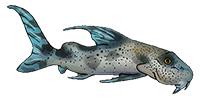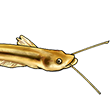Otocinclus with a pink/red belly?
-
lizcateyes
- Posts: 7
- Joined: 20 Jan 2015, 02:45
- My cats species list: 4 (i:2, k:0)
- My aquaria list: 1 (i:0)
- My BLogs: 1 (i:1, p:28)
- My Wishlist: 1
- Spotted: 4
- Location 1: Sacramento
- Location 2: California
- Interests: Freshwater aquaria.
 Otocinclus with a pink/red belly?
Otocinclus with a pink/red belly?
Here's the information for my tank:
1. Water parameters
a) Temperature range. 74-76 degrees F
b) pH. 6.8
c) GH. 30
d) KH. 40
e)Ammonia, Nitrate, Nitrite, levels. 0,0,0
f) Water change frequency 25% weekly
(Most LFS's will check your water and give a list of readings).
2. Tank set up
a) Size. 29 gallons
b) Substrate. sand, small aquarium rocks.
c) Filtration. HOB, intake covered with sponge
d) Furnishings. Planted tank, mostly java moss and java ferns
e) Other tank mates. 10 pygmy corys, 10 male endlers.
f) How long has it been set-up? About 2 years now.
g) When was the last new fish added? over 8 months ago.
h) Foods used and frequency? Hikari micro pellets,
3. Symptoms / Problem description: Oto has a red / pinkish belly?
4. Action taken (if any) None, yet.
5. Medications used (if any) None yet.
I've been keeping otos off and on for a bit, in this tank I started off with 6 when the tank was ready for them in 2016 but I now only have 3. The 3 that passed away before I lost within a few months of purchasing them, no real disease indicators would just find them dead. I know they ought to have more but I haven't seen any healthy ones at the LFS in order to get more. The 3 that are left seem to be healthy and doing fine, and will spend time with the pygmy cory school in the tank.
Today, though, I noticed that one of my remaining 3 otos has a visibly red belly, and I am not sure what could have caused it or how to treat it? Aside from the red coloration, the oto seems to be doing fine, swimming around normally and eating. The tank doesn't have decor in it that doesn't pass my stocking test, and the largest of my rocks would be maybe 1/2 inch in length, not really large enough to damage the underside of the fish? The substrate is mostly sand.
1. Water parameters
a) Temperature range. 74-76 degrees F
b) pH. 6.8
c) GH. 30
d) KH. 40
e)Ammonia, Nitrate, Nitrite, levels. 0,0,0
f) Water change frequency 25% weekly
(Most LFS's will check your water and give a list of readings).
2. Tank set up
a) Size. 29 gallons
b) Substrate. sand, small aquarium rocks.
c) Filtration. HOB, intake covered with sponge
d) Furnishings. Planted tank, mostly java moss and java ferns
e) Other tank mates. 10 pygmy corys, 10 male endlers.
f) How long has it been set-up? About 2 years now.
g) When was the last new fish added? over 8 months ago.
h) Foods used and frequency? Hikari micro pellets,
3. Symptoms / Problem description: Oto has a red / pinkish belly?
4. Action taken (if any) None, yet.
5. Medications used (if any) None yet.
I've been keeping otos off and on for a bit, in this tank I started off with 6 when the tank was ready for them in 2016 but I now only have 3. The 3 that passed away before I lost within a few months of purchasing them, no real disease indicators would just find them dead. I know they ought to have more but I haven't seen any healthy ones at the LFS in order to get more. The 3 that are left seem to be healthy and doing fine, and will spend time with the pygmy cory school in the tank.
Today, though, I noticed that one of my remaining 3 otos has a visibly red belly, and I am not sure what could have caused it or how to treat it? Aside from the red coloration, the oto seems to be doing fine, swimming around normally and eating. The tank doesn't have decor in it that doesn't pass my stocking test, and the largest of my rocks would be maybe 1/2 inch in length, not really large enough to damage the underside of the fish? The substrate is mostly sand.
- bekateen
- Posts: 9646
- Joined: 09 Sep 2014, 17:50
- I've donated: $40.00!
- My articles: 4
- My images: 143
- My cats species list: 146 (i:106, k:34)
- My aquaria list: 37 (i:14)
- My BLogs: 44 (i:154, p:2563)
- My Wishlist: 36
- Spotted: 184
- Location 1: USA, California, Stockton
- Location 2: USA, California, Stockton
- Contact:
Re: Otocinclus with a pink/red belly?
Hi Lizcateyes,
These are your same otos from your post a couple of years ago? That's pretty good to keep three otos this long (at least in my experience, store-bought otos are often very weak and die soon, as your other three did).
To me, the redness says bacterial infection. I can't say what kind, and I'm not good with medications, but I would start by first increasing your water changes, raise your water temperature (at least up to 80F), increase aeration with extra air stone, and consider a broad spectrum antibiotic. Since I don't know what brand to recommend, I'll just say what I would try: If I were in your position, I'd probably start with SeaChem Paraguard. I can't say it's the best choice for your fish, but it seems to be a decent broad spectrum medication. But perhaps not: Paraguard is more of an external medication. If your redness is internal rather than external (in your pictures, it looks to be internal), I don't think the Paraguard will be as effective.
I hope other people with better experience chime in too. Good luck.
Cheers, Eric
P.S., On an unrelated matter, I see from your post that you are in Sacramento. Do you attend the Sacramento Aquarium Society? If not, I'd like to invite you and your family to join us. We meet the first Saturday of each month. Our next meeting is March 3, with a presentation on ornamental shrimp. For details and directions, follow this link: http://sacramentoaquariumsociety.info/m ... tings.html.
These are your same otos from your post a couple of years ago? That's pretty good to keep three otos this long (at least in my experience, store-bought otos are often very weak and die soon, as your other three did).
To me, the redness says bacterial infection. I can't say what kind, and I'm not good with medications, but I would start by first increasing your water changes, raise your water temperature (at least up to 80F), increase aeration with extra air stone, and consider a broad spectrum antibiotic. Since I don't know what brand to recommend, I'll just say what I would try: If I were in your position, I'd probably start with SeaChem Paraguard. I can't say it's the best choice for your fish, but it seems to be a decent broad spectrum medication. But perhaps not: Paraguard is more of an external medication. If your redness is internal rather than external (in your pictures, it looks to be internal), I don't think the Paraguard will be as effective.
I hope other people with better experience chime in too. Good luck.
Cheers, Eric
P.S., On an unrelated matter, I see from your post that you are in Sacramento. Do you attend the Sacramento Aquarium Society? If not, I'd like to invite you and your family to join us. We meet the first Saturday of each month. Our next meeting is March 3, with a presentation on ornamental shrimp. For details and directions, follow this link: http://sacramentoaquariumsociety.info/m ... tings.html.
Find me on YouTube & Facebook: http://youtube.com/user/Bekateen1; https://www.facebook.com/Bekateen
Buying caves from https://plecocaves.com? Plecocaves sponsor Bekateen's Fishroom. Use coupon code bekateen for 15% off your order. Also, for you Swifties: Https://youtu.be/ZUKdhXL3NCw
-
Bas Pels
- Posts: 2918
- Joined: 21 Dec 2006, 20:35
- My images: 1
- My cats species list: 28 (i:0, k:0)
- Spotted: 8
- Location 1: the Netherlands
- Location 2: Nijmegen the Netherlands
- Interests: Central American and Uruguayan fishes
Re: Otocinclus with a pink/red belly?
I´m afraid, as Eric said, the Otocinclus has a rather nasty iunfection. Whether it can be saved, I don´t know
The sensitivity of shop bought Otos is easily explaind. Otos eat all day, but after being caught, therte is nothing to eat, untill they arrive in the petshop, but more often in the house of a tankowner.
The empty belly gets infected, and the fish dies. At least, most of them.
I once arranged it so, that I got the fishes on the day they were imported, and `only` lost half of them. Another time I got Otos which had been in the petshop for more than a month, and so the weak ones were dead already. No losses. Now I have some which were bred by someone - that is, without the stated problems, and therefore no losses
The sensitivity of shop bought Otos is easily explaind. Otos eat all day, but after being caught, therte is nothing to eat, untill they arrive in the petshop, but more often in the house of a tankowner.
The empty belly gets infected, and the fish dies. At least, most of them.
I once arranged it so, that I got the fishes on the day they were imported, and `only` lost half of them. Another time I got Otos which had been in the petshop for more than a month, and so the weak ones were dead already. No losses. Now I have some which were bred by someone - that is, without the stated problems, and therefore no losses
cats have whiskers
-
lizcateyes
- Posts: 7
- Joined: 20 Jan 2015, 02:45
- My cats species list: 4 (i:2, k:0)
- My aquaria list: 1 (i:0)
- My BLogs: 1 (i:1, p:28)
- My Wishlist: 1
- Spotted: 4
- Location 1: Sacramento
- Location 2: California
- Interests: Freshwater aquaria.
Re: Otocinclus with a pink/red belly?
Hi Eric, yes these would be the same otos from my previous post, these 3 have been pretty hardy up until now where the one seems to have a bacterial infection. I'll go ahead and raise the temp in the tank and start treatment with meds today, and hope it can save it. Also appreciate the invite to the Sacramento Aquarium Society, if my family and I can make it we will be there!
-
lizcateyes
- Posts: 7
- Joined: 20 Jan 2015, 02:45
- My cats species list: 4 (i:2, k:0)
- My aquaria list: 1 (i:0)
- My BLogs: 1 (i:1, p:28)
- My Wishlist: 1
- Spotted: 4
- Location 1: Sacramento
- Location 2: California
- Interests: Freshwater aquaria.
Re: Otocinclus with a pink/red belly?
An update on the oto, I had moved it to my quarantine tank and was treating it, it seemed to have been doing better but I found it had passed away last night.




